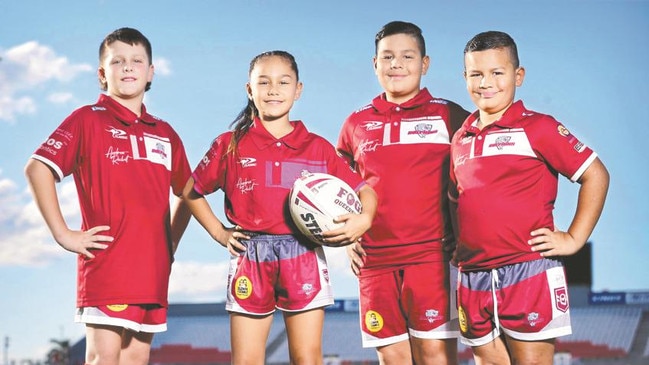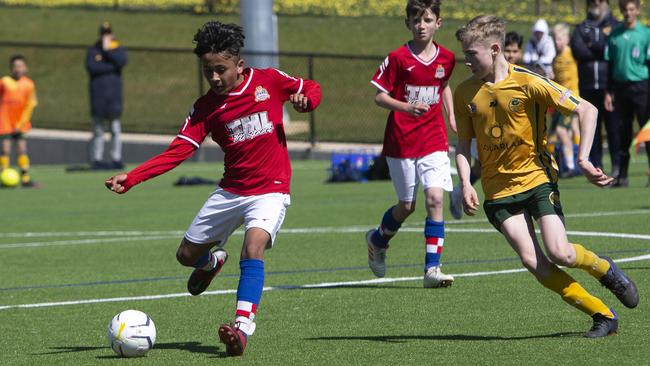Synthetic pitches can save junior sport from growing crisis
The misdirection of $800m in stadium funds is killing our childrens’ sporting future. After three years without junior sport, this is how the NSW Government can ensure the state’s future sport stars are never left on the sidelines.

This isn’t a column about your favourite NRL, AFL or EPL player. It’s about someone much more important than that.
It’s a column about your son. Your daughter. Your grandchild.
They dream of becoming the next Kalyn Ponga, Lance Franklin or Sam Kerr. Good luck.
The athletic development, not to mention the psychological impact, on thousands of young girls and boys is being stunted, to a dangerous point of urgent attention.
There is a crisis in the suburbs and it needs to be addressed. First it was due to the drought of 2019, then the abandonment of junior matches and seasons due to Covid and, most recently, the washout of anything to do with running, kicking or chasing a ball on your local oval due to the deluge of wet weather. Across NSW, there are thousands of kids who have been unable to complete a full season of community rugby league, Auskick or soccer in three years.
Stream every game of every round of the 2022 NRL Telstra Premiership Season Live & Ad-Break Free In Play on Kayo. New to Kayo? Try 14-Days Free Now >
You can add other sports too, like baseball, OzTag, touch football, rugby union and grass-field hockey and netball.
Councils, desperate to preserve their fields and ovals from turning into quagmires are closing fields to the point where teams haven’t even trained together this season. Some coaches still haven’t met their players.
Some kids asked mum to buy them $150 boots in February before the footy season. They have never worn them and are about to grow out of them.
It’s almost May. Across NSW there are thousands of kids who have been sitting idle for three years.

They’re registered to play, but aren’t allowed to enjoy the freedom of past generations running around on Saturday and Sunday mornings.
This is where the NSW government needs to get their head out of their proverbial and realise it’s not the 1980s.
Instead of redirecting all of the $800m of funds – saved from not proceeding with the redevelopment of Accor Stadium (formerly ANZ) – into the refurbishment of suburban stadiums, the NSW government must pour some of the money into providing communities and councils with all-weather synthetic fields.
It’s the only way to break the cycle of inevitability that will continue for years to come for a generation of kids being starved of community-based team sports.
Unlike 1982, when soccer and rugby league used the grass-fields in winter before cricket took over in summer, the rise in more sport offerings and, importantly, girls’ participation across all codes, has led to more teams, more training session times and more foot traffic.
There are more sports for councils to cater for, with summer OzTag, hockey and soccer rising at a rapid rate, as soon as the winter competition of the equivalent is over.
According to Football NSW, over the past five years, an estimated 35 plus synthetic fields have been installed in NSW, which are allowing clubs, associations and local governments continued usage, far in excess of any natural playing field capacity.

Football NSW adds: “There is a limit to the hours natural turf can be used before there is a significant impact on surface condition.”
A high quality natural turf surface may only withstand use for up to 20 hours per week before it starts to deteriorate.
“Synthetic surfaces can sustain significantly higher use than natural grass, with 60 hours plus per week as an acceptable expectation.”
The cost of a synthetic pitch sits at around $300,000. I love suburban stadiums.
Penrith, Cronulla and Brookvale Oval are special places on game day. The buzz and atmosphere of walking to the ground, through the streets with hundreds of other like-minded souls, creates a feeling of belonging and a sense of community.
But who will play inside these flash new stadiums if the current generation of kids aren’t given a chance to athletically develop?
How can they aspire to be Ponga, Franklin or Kerr, if they can’t play themselves?





To join the conversation, please log in. Don't have an account? Register
Join the conversation, you are commenting as Logout